The biohack.me forums were originally run on Vanilla and ran from January 2011 to July 2024. They are preserved here as a read-only archive. If you had an account on the forums and are in the archive and wish to have either your posts anonymized or removed entirely, email us and let us know.
While we are no longer running Vanilla, Patreon badges are still being awarded, and shoutout forum posts are being created, because this is done directly in the database via an automated task.
Low-tech approach
Comments
-
Version one is donut-shaped Nd magnet (red and blue) suspended by extension springs (yellow) in a non-ferrous capsule (magenta). The compass magnet can freely rotate on the two spindles (cyan) holding it. Through the donut-hole will be a non-ferrous balanced rod (orange and green) and a bushing. When the compass faces magnetic north the rod will tap against the small ledge inside the capsule whenever the unit is jarred. The tapping sensation should be felt by the user.The unit should be implanted in a location which receives some jarring during walking so the tapping is noticeable with each step.The unit will be encased in a bioneutral coating and the long "nipples" at the top and bottom will be less of a poking threat. The coating would also be contoured so that the until would not rotate once implanted. The internal ledge must always face north.Currently, this system will only tell the user when she or he is facing north.
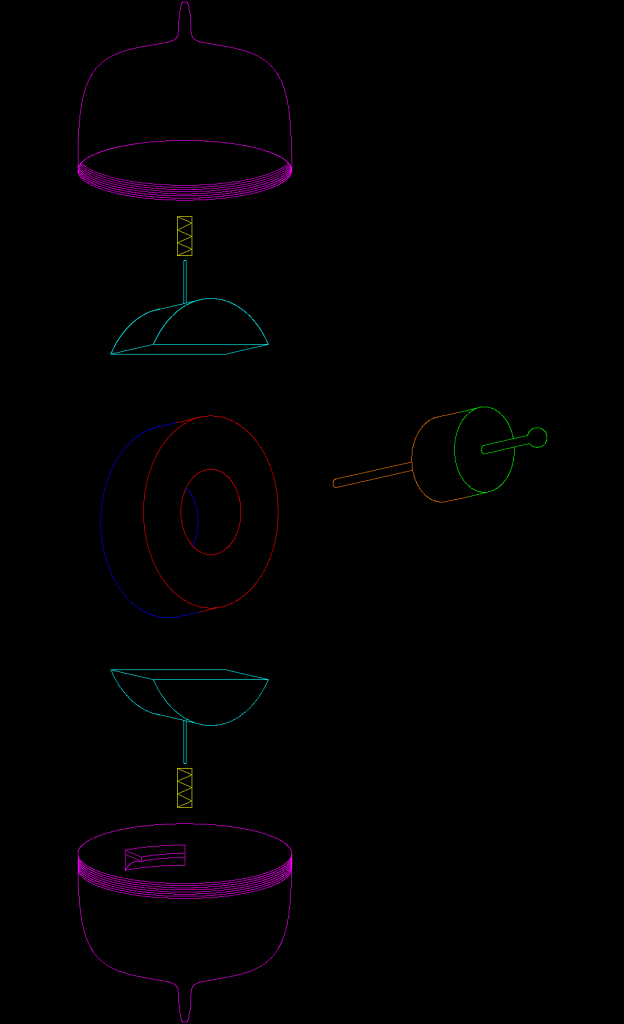
-
Version two uses a disc shaped case (white) and is similar to a traditional needle compass. The same internal ledge (green) is employed. The magnet (red) is suspended by spikes (magenta) so it may rotate freely and change angle enough to impact the ledge. This design requires stoppers (blue) be used so the needle cannot spin 180° which would cause the needle to tap on the opposite ledge when facing south. The top half of the case is not shown but is identical to the bottom half.This device needs to be installed horizontally such as a shoulder. Note: backpacks, purses, messenger bags and similar put significant pressure on that region. The device could be installed on a forearm but the arm would need to be held horizontally for the compass to work. During driving and while riding certain styles of bicycle the forearm may be correctly oriented.
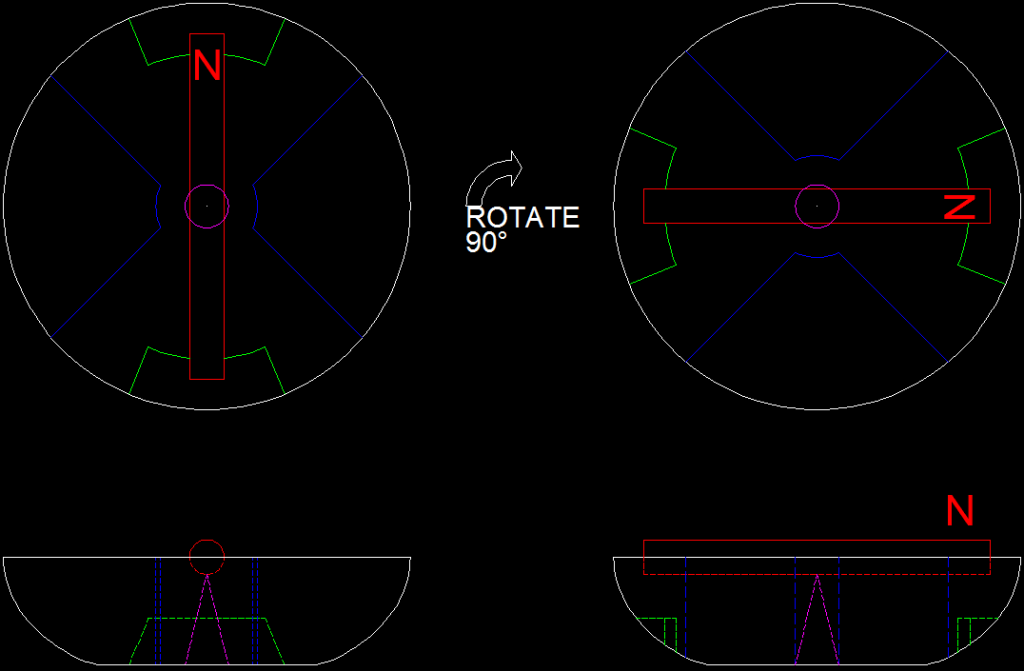
-
In theory this would work. In practice you may face problems of biological nature. The mechanical motion would translate into a tiny acceleration and deformation of the skin, to pick those up the body has special sensoric cells. Those are primarily located in the fingertips, the lips, and the genital area. Outside those areas, the density of said cells is very low and can only pick up rather rough mechanical influences. Even worse, those cells are also frequency dependent. The lack of the required fine mechanical sensory is pretty much the primary reason why most people go with electronics. As amplifying tiny signals and outputting it bigger skin areas is easy, compared to mechanical systems. Having said such discouraging words, there are still chances to make it work under certain conditions. You could try to build a very simple prototype and glue it to your fingertip for testing. The faster you'd rotate the case (assuming your bearings are perfect), the stronger the feedback you get, but also the less accurate. Worth a try i guess. For testing you could use a set of coils to produce a rotating field so you can test the feedback you get at certain angular speeds of the magnet without spinning in circles.
-
Thank you, I see your point. Either of these devices will spread a tiny impact to a large surface area which translates to a small sensation at any particular point. What if the internal compass impacted a "whisker" that went from the inside of the compass to the outside? Even my forearm, which is less sensitive than most parts of my body, can feel the sensation of a single hair being nudged.
Have whiskers ever been discussed?
-
Whiskers! Someone make a whisker thread!quick note tho: if you hunt through the forums or around on the web, transdermals are a huuuuge pain in the ass. since it's not actually part of us, we don't heal up to it nice and smooth like. there's always this bit of opening where infection can take place.that being said... Whisker thread! c'mon guys!
-
Hairs have their own sensory, but when you implant things you no longer have access to the benefit of the hair-lever-system. Adding a subdermal wisker to sort of reimplement this sounds like a promising idea.
-
The whisker could be transdermal. At that point we'd essentially be building on the back of a 20 gauge piercing. The whisker could also be a short nub that rests against the underside of the skin. It would have to be rubber or something flexible enough so that it wouldn't simply abrade through the skin. I have thoughts about transdermals. Isn't every piercing essentially transdermal? It goes from the surface of the skin to below the skin and often back out again. What if someone had snake bites but they had an implant between the two posts instead of holes going to the other side of the lower lip? Is there a better thread for this discussion?
-
Yes, you start a thread about whiskers.quick note- every piercing is not a transdermal. most pierce the skin and the skin heals, leaving a "skin tube" in which the piercings sit. however, there are transdermal piercings (like those beauty mark piercings) which attach to a subdermal mount, and they often have to be replaced / have issues with rejection greater than a standard implant of the same size / have issues with infection.still, go for the whisker thread and see if anyone have hack a solution
-
The tangent of whiskers has been rerouted to
http://discuss.biohack.me/discussion/498/whiskers-as-feedback-devices
I've seen how the transdermal piercings work which is why I would never get one. Correct me if I'm wrong but transdermal piercings are considered healed when skin grows around the anchor section of the foot-looking part. The post cannot be switched or even removed, only the bead.
A surface piercing, like an angled barbell, goes all the way through the skin at one point and comes all the way out at another point on the same plane of skin. They are healed when the skin around the piercing sites has ceased to be a wound. The barbell may be swapped without help. They are less likely to reject than surface piercings.
-
correct.this is due to the fact that "healed" for transdermal means that it has stopped being a mess, while "healed" for a barbell means that the skin is sealed from outside influences. On the micro level, even if your skin has grown around the anchor point, you still have an active hole in your body, which is to say, you have a puncture in your very important protective coating, your skin.
-
If an implant was installed under the skin and had two posts protruding from the skin would that be considered a transdermal? There is nothing anchored in the skin itself.
-
no. refer to my post about skin tube. after a barbel piercing has healed, there is no opening in the skin to the outside. therefore, it is no longer crossing the surface barrier. transdermal means crossing the skin barrier.that isn't to say that the body won't eventually heal out the piercing. skin wants to return to its programmed state. this is why piercing holes shrink over time.
-
Has anyone had success with an implant that had accessible posts?
-
I might be a little late to the party here, but I had a bit of a brainstorm and a friend of mine suggested a possible change to your implant design.
Instead of having a rigid ledge that the rod taps against, would it be more effective to use something like the 'wheel of fortune' to produce a clicking sensation as you pass a certain bearing? You could have a few of these points close together to make the sensation more noticeable (since that seems to be an issue), as well as being able to point out other directions, ie 3 clicks for north, 1 for south.
What do people think, could this potentially improve accuracy/sensitivity when using the device?
-
@Nightgaunt I like it. The Wheel of Fortune analogy is great and really pulls your idea together.
The scale prototype I've been cobbling together is a ping-pong ball with a wire whisker sticking out of it at the NORTH position. Your idea of putting numbered clusters at different locations is insightful. The most obvious flaw of the original is that it only worked for one direction (not a plug for the band). The idea I had been toying with was to have whiskers sticking out at the cardinal directions but that isn't great for a few reasons. Your idea could work as an implant almost anywhere.
The hurdle I see right now is how do we make something inside that has enough force to tap the chassis or a whisker but doesn't stop the compass spinner in its tracks? I'd like some ideas of material I can actually use for the prototype, they don't have to be biocompatible at this stage, just enough to prove the concept.
I'm thinking that a stiff whisker poking through some fishing lure material will provide enough of a buffer that the compass can pass over the whisker and gently tap it while continuing to spin. I'll try to post a picture this afternoon so you can see what I've got going.
Welcome to the party, Nightgaunt.
-
Pics of the compass:

This first image shows the back of the compass which is a ping pong ball with a section cut out. When you stand south of the compass you see this magnet with a white piece of tape. There is a piece of green tape on the other side.
The two disc magnets are glued to the cap of a pink highlighter which was sacrificed for the project.
The wood screw through the middle is made of brass otherwise the two Nd magnets would simply stick to it.
The little piece of wire sticking out the right side is the "whisker" which gets tapped when the compass faces the same way as the wire. The whisker is shown in the second image from the inside.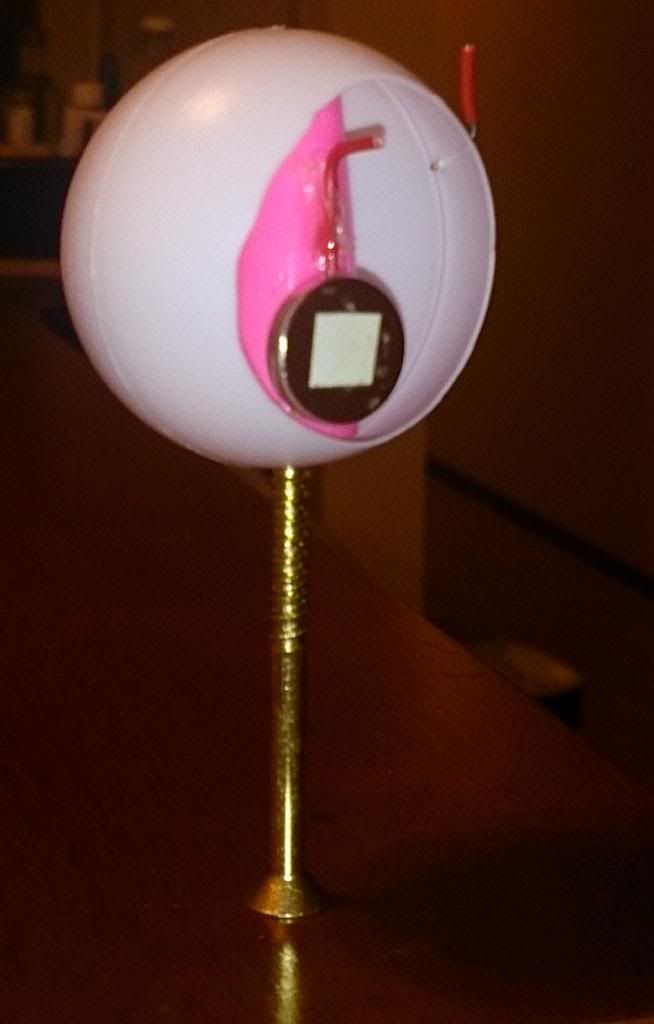
Here is a rotated view. The part of the whisker on the inside of the ping pong ball is visible. The impact of the wire sticking off the spinning compass part and the wire sticking through the ping pong ball create the Wheel of Fortune affect of tapping when facing a particular direction.
Ideally the ping pong ball would not absorb much of the impact between the two wires and most of the force would be transferred to the whisker and therefore nerves.
This is of course a model which has been scaled up. None of these parts are intended for implantation into anyone.
Here is a video of me spinning the brass screw, thus rotating the ping pong ball. It clearly points north without fail and hopefully it's clear how the whisker will be tapped when rotated through the correct angle.
http://s664.photobucket.com/user/phreak-of-nature/media/Simple%20Compass/2014-02-17202010_zps710006d3.mp4.html
Here is that same video on youtube
https://www.youtube.com/watch?v=PHyhBochhFE
-
The compass has been upgraded with fishing lure material. The wire sticking through the ping pong ball has been replaced with a short length of magnet wire and bent on the inside. The Wheel of Fortune analogy is even more appropriate now.
This is the material I used. Nothing fancy. I wound up using just the tip, Archer reference, which turned out to be roughly the same diameter as a standard hole punch.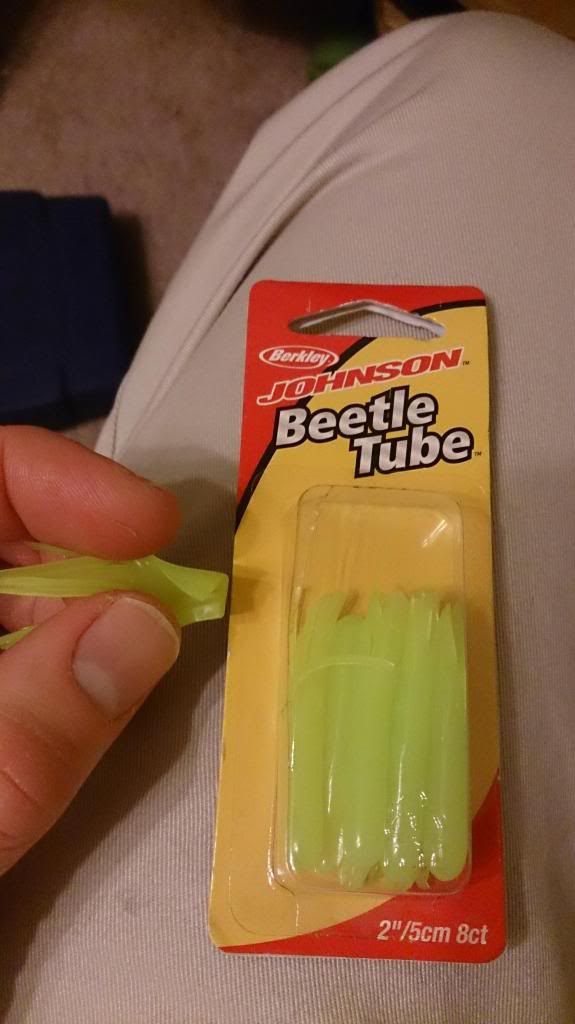
From the outside you can see the whisker sticking out. There is also a hint of my cat.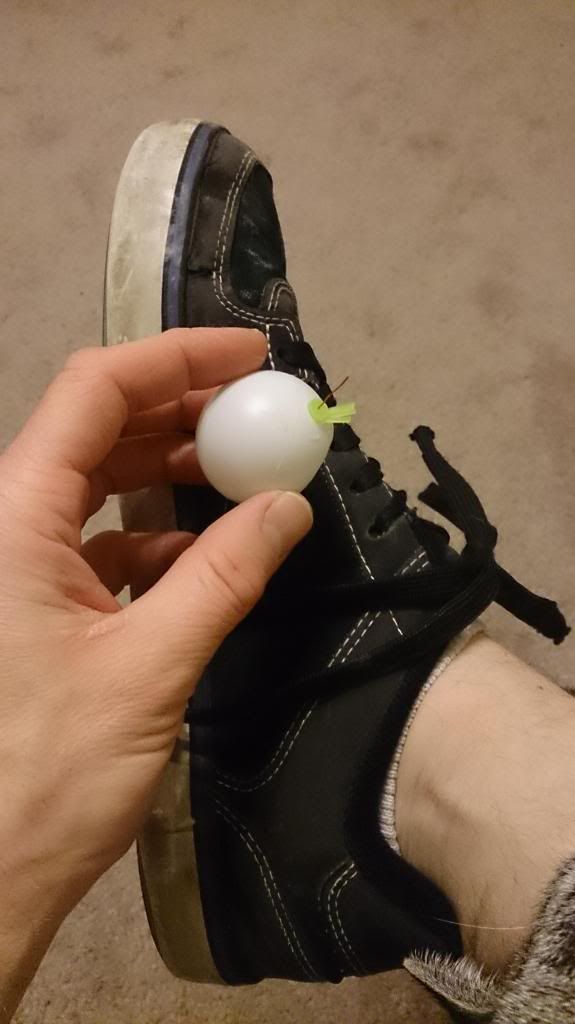
Here is whisker from head on.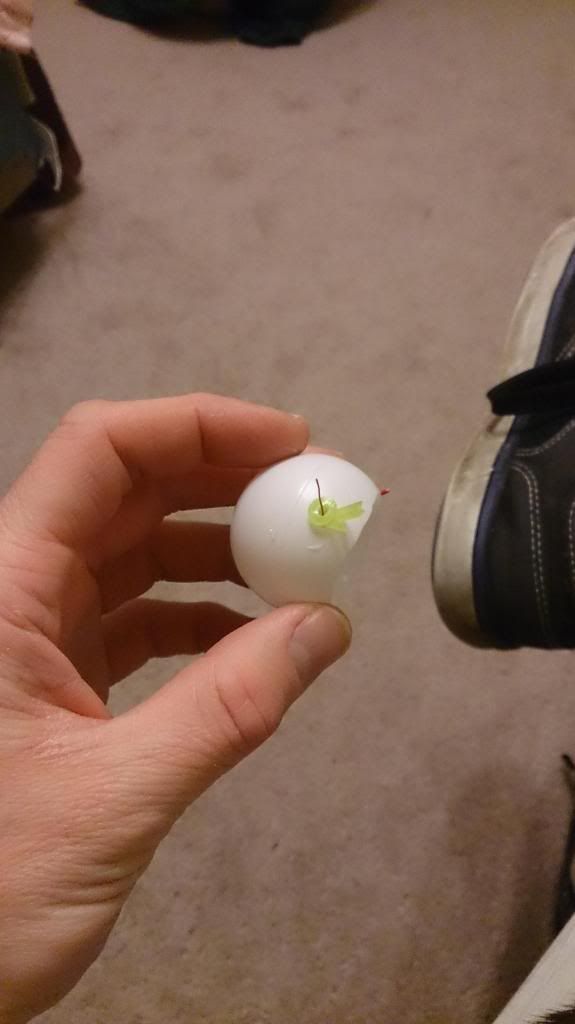
I plan to make a photo rig which will focus on the spinner and whisker while keeping the camera stationary in respect to the screw and ping pong ball. This should allow me to make a clear video of what happens when the compass goes to the angle I'm sensing.
Thoughts so far?
-
Here is a short video of the compass tapping on the whisker. Hopefully you can imagine that even scaled way down the whisker will provide ample sensation.
http://youtube.com/v/_U5CsGqY0Ts -
Great clip, McStuff ... Can't wait to see your next step.
-
The other day I bought a cheap pill case. I assume it's aluminum.
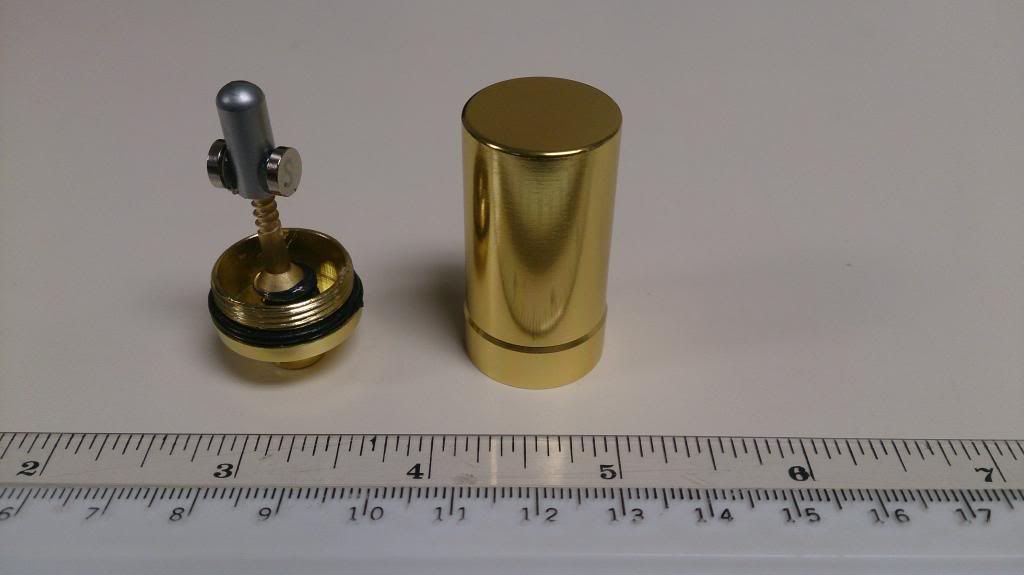
Most of the parts of this model are similar to the ping pong ball model. There's a compass spinner on top of a brass screw. Only this time the whole unit is enclosed in an aluminum shell.
The next step will be to drill a hole in the pill case and put a whisker that can be tapped by the spinner and make it sensible from the outside.
I'll wear this for a few days on my arm or something and see if this design is usable as a haptic compass.
-
Can't wait to hear the results.
-
I have noticed that when the whisker is being brushed past by the pin of the compass, there seems to be a moment of "stretchiness" (for lack of a better word) where the pin is held back for a bit. would this affect the accuracy of the reading at all? or would you be able to tell that you are pointing north purely from the first contact of the pin with the whisker?
-
@Dragon5, well spotted. The idea is that you get a sensation when the compass faces north. That sensation would probably be a tickle or something akin to a breeze blowing across a single hair. If one of these compass units were strapped to the back of your leg and you walked in a circle you would only notice the tickle when you walked north.
Of course you could build yourself seven similar units and make a ring like a Northpaw but each of them would have the whisker facing a different direction and the wire inside the compass would also face a different direction.
I am pondering a different design which uses a spherical magnet. This would reduce the complexity and size of the compass spinner. Thoughts, anyone?
-
hm. a spherical magnet swimming in a liquid , like those marine compass models. sounds pretty good idea.
-
I hadn't given much thought to filling the compass. It would make the most sense though. Correct me if I'm wrong, but the purpose of a liquid filled compass is the viscosity of the liquid, probably ethyl alcohol in my case, dampens sudden movements for a more reliable reading. If this were implanted in a leg that would be important.Nothing says sterile like assembling a vessel while it is submerged in alcohol.What does alcohol do to silicone?
-
Here is my next step. I've taken a cheap aluminum (aluminium if you live outside the states) flashlight and removed the guts. This left me with a small diameter tube of Al. I mounted the same screw seen in the pill capsule model to the switch end. The same spinner fits very neatly inside the body of the flashlight. Just barely though. On top of the spinner is a straw which has been cut away so it will only interact with the whisker when facing a certain direction. That sentence will make sense soon.
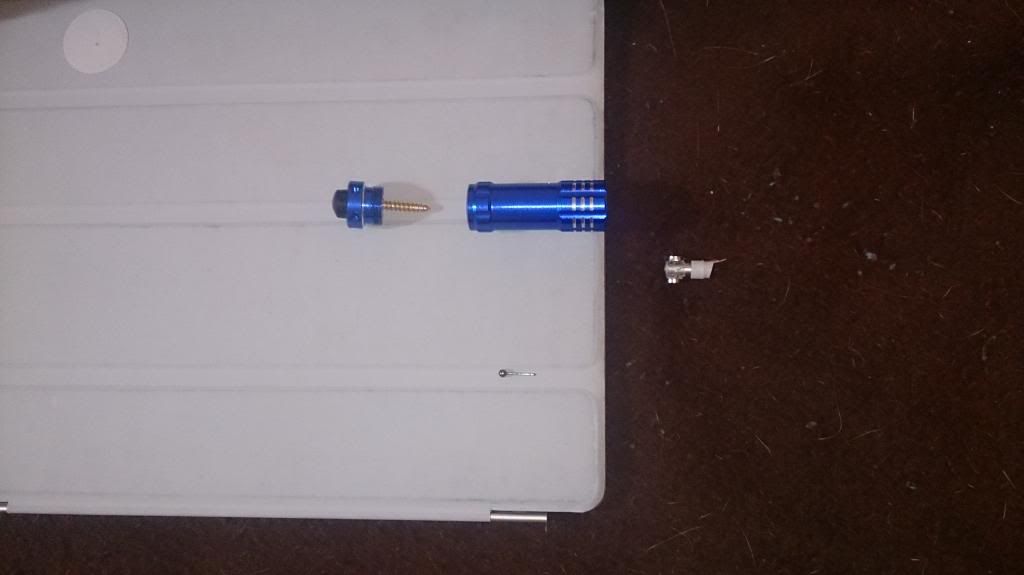 Also shown is the 20 gauge titanium piercing which will act as a whisker.Here is a video of me putting the whisker into a small hole drilled in the side of the flashlight.
Also shown is the 20 gauge titanium piercing which will act as a whisker.Here is a video of me putting the whisker into a small hole drilled in the side of the flashlight.
Here I insert the spinner into the flashlight body while holding the whisker out of the way.
For the next video I turned on the camera light so the spinner was visible while I spun in an office chair. Hopefully this demonstrates how the straw and whisker will jiggle when facing north.
Lastly I have a picture of what the whisker looks like after being held in place with silicone. I hope there is enough mobility to jiggle the whisker.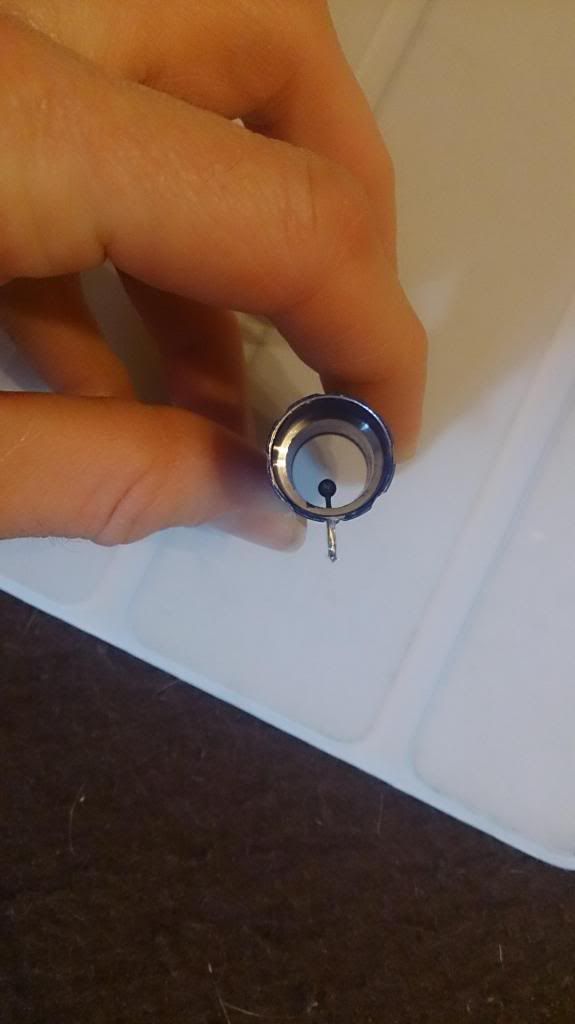 That's the latest iteration of the simple haptic compass. My next step will be to make this wearable and strap it behind my leg. There will be a large gap so the whisker just barely grazes my leg. My hope is that after wearing it I can judge whether an implantable version is practical. Should I shave my leg in the area so the whisker grazes my skin or try to position the whisker right on a hair?
That's the latest iteration of the simple haptic compass. My next step will be to make this wearable and strap it behind my leg. There will be a large gap so the whisker just barely grazes my leg. My hope is that after wearing it I can judge whether an implantable version is practical. Should I shave my leg in the area so the whisker grazes my skin or try to position the whisker right on a hair? -
@McStuff Wow you made some progress on that. I would place it on bare skin not hair, as the hair's stress detection capabilities won't be available for an implant. Then again...I'd imagine any sensation will be amplified when placed below the skin vs outside so maybe using a hair would help offset that...hmm. Also, @glims mentioned on the whisker thread, before it died, magnetic shape memory alloys as an alternative to (or material for) whiskers. Really seems to be worth looking into.
-
Why not using a little compass instead of the big one with magnets and then finding a way to make it interact with the whisker? And something like this could be implanted if we coat it on silycone, right?

-
Sure but...
1. A toy compass is not rugged enough to be implanted.
2. The overall shape of this compass is disc-like and inconvenient for implantation while the ones I'm focusing on are tube-like.
3. The magnet in the toy is not strong and more strength means more mass which interacts more with a whisker.
Beyond those three factors what you're describing is EXACTLY what I want to do. How would you overcome those three factors?
